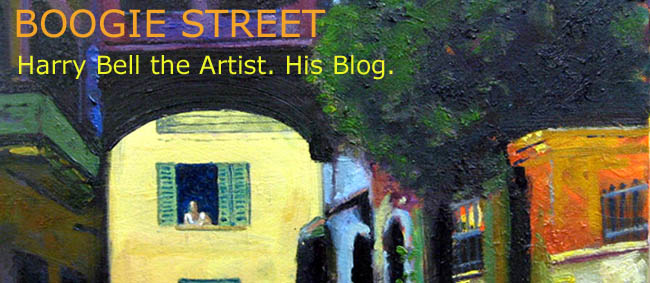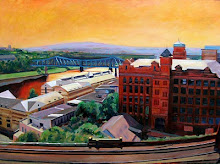
Balcony, GOMA
When it opened as a gallery of modern art, it came in for a lot of criticism from the "art establishment" who considered that it was too "populist." They were right - it has indeed become very popular, with over 400,000 visitors a year, and none the worse for that! This is a modern art gallery which everyone can enjoy, even those who would not normally consider themselves "arty". And the art which has been acquired for this gallery has been produced by living artists. There is much of Glasgow here, of course, with Beryl Cook's "By the Clyde" (pictured here) and "Karaoke" and the minute detail of a Glasgow tenement in Avril Paton's "Windows in the West."Yeah, that was what I thought, too. I went to GOMA in 1996 and thought the collection on display was really interesting, so I was looking forward to going again while we were in Glasgow. Pat isn't familiar with the work of the "New Glasgow Boys" (Peter Howson, Steven Campbell, Adrian Wiszniewski, Ken Currie) and all the guidebooks and leaflets assured us that their work is well-represented there.
Peter Howson, whose work has been purchased by major corporate and private collectors in the UK and USA, is well represented with his sometimes brutal figures and the gallery seems to enjoy presenting three dimensional perspectives which make people stop and blink, such as "The Shadow of War" by Patrick Hughes. And there are not too many art galleries with sculptures of "The King" (Elvis Presley, complete with halo) and the Queen (in carpet slippers and dressing gown). Yes, definitely, populist! - Places to Visit in Scotland
Well, it isn't. There's one very large painting by Adrian Wiszniewski carefully hung on one of the landings of the stairwell, such that it's actually impossible to get further than two feet away from it. Other than that, nowt.
Perhaps I might have been forewarned if I'd seen this on the GOMA website before I went:
Photography, video and installation from Glasgow Museums' contemporary art collection - open now.
It's that word "contemporary", isn't it? Had I read that signal, I might have been prepared for the sight of two floors of visually non-descript prints and photographs, with their explanatory labels - labels with short stories which bore little or no relevance to the pictures next to them. Or perhaps it's fairer to say that the pictures were the irrelevance; as Pat said to me, some of the stories might be interesting to read in a magazine, but did they deserve to be put on the wall with a pointless "illustration"?
The best part of the museum is the neo-classical building itself and we enjoyed talking to a helpful attendant who offered a potted history of it, complete with tales of the tobacco and slave trade which paid for its construction. But in that respect, it reminded me of nothing so much as the Baltic in Gateshead, where people come to look at the building and are generally indifferent to the contents. The few other people in GOMA were, like us, drifting through the floors of exhibits like lost souls hoping that something might leap out and grab their attention. No such look.
The ground floor, the biggest exhibition space they have, had all its windows blacked out so that it could be given over to a video installation by Fiona Tan: "two screens, this work is an atmospheric portrait of a group of schoolchildren that challenges assumptions about identity, race and ethnicity." Ho hum. The whole floor, for one video presentation, presented as if it were a religious experience. Give me strength. No one was watching it, by the way.
On the way out we asked one of the attendants on the desk what had happened to the permanent exhibition, particularly the New Glasgow Boys' work. She looked uncomfortable, and waffled a bit about how they liked to rotate their collection and of course there was the question of conservation and the problem of sunlight and .... Yeah, right, oil paintings suffer so much from sunlight.
As it turns out, some of the work referred to in the piece at the beginning of this post (the Avril Paton painting and the sculpture of Elvis) have obviously been transferred permanently to the Kelvingrove Art Gallery and Museum, because sure enough, there they were.












2 comments:
Glad you're back, Harry, and am looking forward to reading your reports on your Glasgow trip.
--
Bruce T.
I expect they'll be along Real Soon Now, Bruce.
Post a Comment